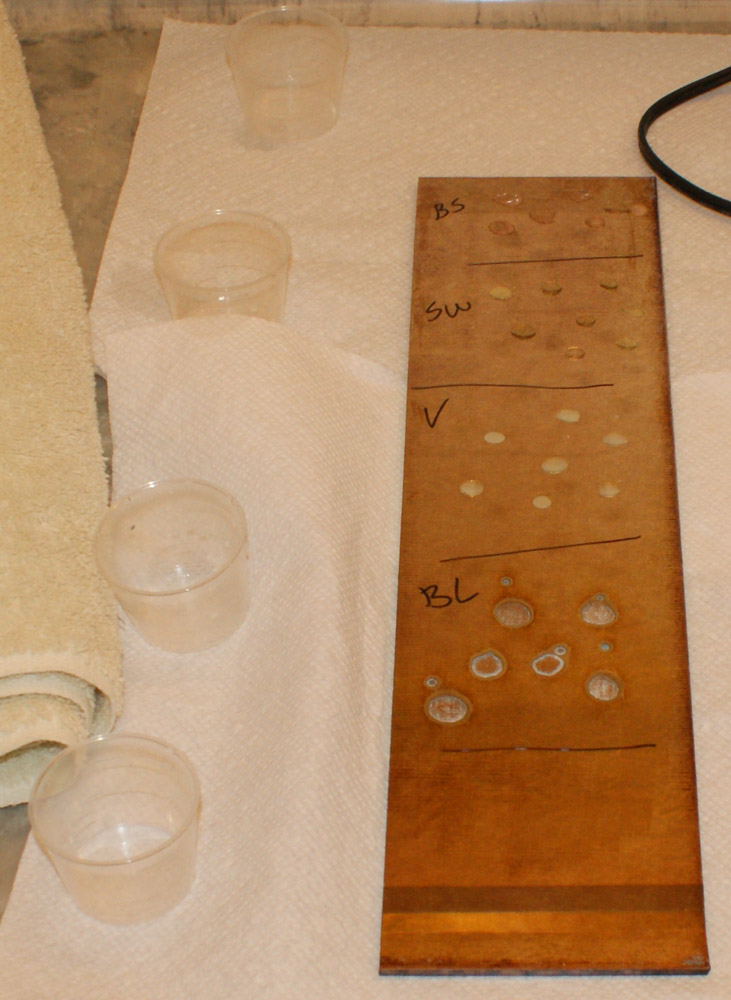DIY & Home Improvement
Related: About this forumAnyone ever faux aged a mirror?
Last edited Thu Jun 6, 2013, 09:58 PM - Edit history (1)
I'm making a hall mirror / key rack using leftover scraps from my table build and I want to take the new mirror glass I cut to fit and give it a nice old look.
I took a scrap of mirrored glass and stripped the protective coating on the back off, and I've tried some household chemicals.. baking soda, salt water, vinegar, and bleach. Bleach seems to remove the silvering too quickly, vinegar seems to remove it too evenly. Salt water took it off eventually, and the water spots look natural. (Baking soda did nothing.)

Any other common household chemicals to try?
eta: I believe a 70/30 bleach solution is going to do it nicely, if spritzed on, left for 60-90 seconds, then immediately washed off.
Warpy
(113,130 posts)and blot it on with cotton or crumpled newspaper.
I seem to recall that worked remarkably well.
X_Digger
(18,585 posts)It seemed to evaporate too quick to do anything.
At least the fingerprints are gone! ![]()
CountAllVotes
(21,068 posts)Everyone out there should have a bottle of this stuff around.
It takes lots of things off that you'd never imagine -- i.e. a rather thick black felt tip pen mark on a new counter top. Took that mark right off in a matter of seconds.
Magic I tell you, magic!! ![]()
Adsos Letter
(19,459 posts)I have a great book on chemical patination, but it's buried away in storage (we're in the middle of a remodel). ![]()
There are ways of patinating silver with sulfides, but they are extremely toxic if not done properly.
I was a painter during my working career, and spent the last 15 or so years doing lots of specialty finishes, and metallic leaf work (gold, silver, copper, variegated, etc.) Most of our special treatments for metals were done with simple glazes, although we did use a soldering flux for aging copper. We actually purchased the book on patination (an industry manual) in hopes of incorporating those techniques. Never got around to doing much of it, though.
So...I've typed all this, and I haven't actually helped you at all. we're going to storage on Sunday; if you haven't figured it out by then, I'll look for that book.
How are you applying the bleach? Have you tried one application with a weaker bleach/water mix, followed by a stronger one, using combos of sea-sponges, squirt bottles, rags, etc? One of the things I learned with glazing, faux bois, marbling, etc., is to work in layers. I suspect that could be true in what you're doing. Perhaps using different chemicals in separate applications?
X_Digger
(18,585 posts)I'm going to do a rather strong solution along the very bottom of the mirror with a q-tip.. give it 45-60 seconds, then rinse.
Then switch to a weaker solution and a spray bottle, go a bit higher, then a very weak solution and hit the whole thing.
eta: And I think I'm going to play with the paint colors for re-covering the mirror.. maybe some silver, maybe some gray, then black.
Adsos Letter
(19,459 posts)Depending on the age of the mirror, and the method of silvering, it may be soluble in various concentrations of ammonia.
Yes, I would imagine that the backing colors will have an effect. In the case of metal leaf work, various bole colors are used to impart warmth, etc. And, depending upon the point at which it is done, sizing can also "drown" the leaf, reducing it's vibrance. I don't know if any of this works on whatever method was used to silver your mirror.
I think layering is the key in the approach you are taking.
Good luck, and post a photo of the results. ![]()
X_Digger
(18,585 posts)I'm letting the paint stripper do it's magic today, I should be starting on it tonight. I'll definitely post pictures when the whole thing's done.